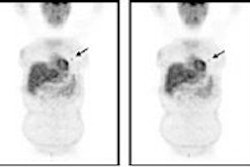Breast imaging veterans frequently lament the lack of interest in the field by new radiologists, but a brief survey of the legal history of mammography reveals why the specialty seems unappealing: Malignant neoplasm of the female breast is the most prevalent condition resulting in malpractice claims. Perhaps not surprisingly, radiologists are the most frequently sued specialists.
And that's just the beginning of some rather gloomy statistics from such tracking agencies as the Physicians Insurers Association of America (PIAA), noted Dr. Leonard Berlin, chairman of radiology at Rush North Shore Medical Center in Skokie, IL. In a two-year period (2002-2004), the average cash payment for mammography-related lawsuits jumped 35%, from $301,000 to $400,000. In one case, a one-week delay in diagnosis resulted in a payout of $250,000.
"The longer the delay, the greater the award," said Berlin in a talk at the 2004 American Roentgen Ray Society (ARRS) meeting in Miami Beach, FL.
But the situation isn't hopeless. Berlin, who also serves as a member of the American College of Radiology's committee on ethics, outlined the major reasons that breast imaging has wound up in these legal crosshairs, and offered some tips for improving mammographic interpretation and minimizing the threat of litigation.
Road to the courtroom
In a twist of fate, the breast imaging community must shoulder some of the responsibility for this litigious environment. Over the past decade, as the performance of breast imaging has improved, the number of lawsuits filed has increased as well, Berlin said.
As a result, patients now have much greater expectations of what mammography can do for them. And if those high expectations aren't met by mammographers, it can lead to disappointment, anger, and, quite possibly, a lawsuit.
Meanwhile, cancer screening advocates have done a fine job of promoting and encouraging women to undergo annual screening exams. The flip side is that as patients' assumptions about the benefits of mammography increase, so do their perceptions of the damage caused by delayed diagnosis.
"We have oversold the efficacy of mammography," Berlin said. "But one of the most disputed issues is, does early diagnosis reduce breast cancer mortality?"
A published analysis of the error rate of mammographic interpretations showed that 30%-70% of breast cancers detected on follow-up mammograms were retrospectively visible on the initial films. Another study found a 40% disparity among U.S. radiologists with regard to biopsy recommendations among women who were later proven to have cancer. Finally, screening mammography's sensitivity rates have ranged from 70% to 90% depending on the age of the patient.
Unfortunately, these limitations are rarely mentioned to healthcare consumers in advertisements or other media touting breast cancer prevention with mammography.
"Have we told this to the public?" Berlin said. "Informing the scientific community is like preaching to the choir." This lack of information not only affects women, but the general population as well, i.e. those who make up juries. Berlin urged his audience to bear in mind that 75% of jurors follow their own beliefs, regardless of instructions from a judge to only consider the evidence presented in the case.
Improving accuracy, curbing misperception
Berlin offered the following advice for refining mammographic interpretation and perhaps helping spark a downward trend in lawsuits:
Play by the rules. Both radiologists and technologists should adhere to the Mammography Quality Standards Acts (MQSA), as well as the ACR's practice guidelines. "The average lawyer knows more about the ACR guidelines than the average radiologist," Berlin said.
Back to school. A 1992 study in Radiology showed that continuing education related to mammography can increase the accuracy of interpretation. Comparing old and new films, as well as double reading, also helped hone breast imagers' skills (Radiology, July 1992, Vol. 184:1, pp. 39-43).
Consider new technology. Computer-aided detection (CAD) has been found to increase interpretive sensitivity by as much as 21%. Full-field digital mammography (FFDM) is another option, although Berlin stressed the importance of, once again, following ACR guidelines regarding its use.
He also warned that there is a downside of using new technologies -- being sued for either using it prematurely or refraining from employing it all together.
Honesty is the best policy. A full disclosure of the benefits and limitations of mammography is paramount. Berlin noted that too many public-service ads make a simplistic link between mammography and "saving lives." But if a cancer is missed, then the perception is that the mammogram failed to show breast cancer; therefore the interpreting radiologist cost someone her life.
No right answer. More than in any other medical arena, a delayed diagnosis of breast cancer is seen as adversely affecting treatment and prognosis, Berlin explained. That's what attorneys and witnesses debate in the courtroom, and the wide divergence in published reports on delayed diagnosis adds fuel to the fire.
He suggested that radiologists keep the two major components of a malpractice claim in mind:
- Liability -- Was there negligence on the part of the physician?
- Causation -- Did that negligence cause injury?
Causation, or proximate cause, plays a significant part in the amount that is awarded to a plaintiff, he said. If the public continues to perceive mammographic screening as perfect, and that breast cancer is 100% curable, then radiology will remain in the uncomfortable position of making promises it cannot keep.
By Shalmali PalAuntMinnie.com staff writer
July 15, 2004
Related Reading
California law shrinks malpractice payouts - study, July 13, 2004
Reports to FDA allege damage to breast implants during screening, June 15, 2004
Malpractice fears may initiate more false-positive mammograms in North America, September 16, 2003
Making mammographers better: The last link in the imaging chain, August 29, 2003
Driving improvement without driving the docs away: rethinking the MQSA, May 27, 2003
Copyright © 2004 AuntMinnie.com



















